For centuries, dogs have served humanity in diverse capacities, evolving from indispensable workers to cherished family members. While their roles have broadened, the inherent instinct for protection remains strong in many breeds. Once primarily bred for fighting, hunting, herding, or guarding property, today’s discerning owners seek a unique blend: a powerful protector that is also a gentle, loyal companion suitable for family life. The search for the Best Medium To Large Size Family Protection Dog involves careful consideration of temperament, trainability, and compatibility with children and other pets.
This guide explores prominent breeds renowned for their protective instincts, intelligence, and unwavering loyalty, highlighting their unique traits that make them exceptional guardians while seamlessly integrating into a loving home. We’ll delve into their histories, temperaments, and specific needs, empowering you to make an informed decision when choosing a steadfast guardian for your loved ones. These breeds offer both peace of mind and unconditional affection, proving that a formidable protector can also be your family’s best friend.
Protecting your family also means ensuring the well-being of your furry guardian. Understanding their potential health risks and providing comprehensive care is crucial. Some owners might also be looking for specific traits beyond protection, such as cute dog breeds and their price or those with minimal shedding.
Understanding the Traits of a Superior Family Protection Dog
A truly exceptional family protection dog balances powerful guarding instincts with a stable and affectionate temperament. It’s not just about size or bark; it’s about intelligence, trainability, and a natural devotion to its human pack. These dogs are alert and vigilant, capable of sensing threats, but equally gentle and patient with children. Proper training and early socialization are paramount, transforming their protective drive into a reliable, controlled defense mechanism rather than aggressive impulsiveness. Owners must be prepared to invest time in consistent training to harness their potential, ensuring they are well-adjusted and safe in various social situations. Without proper guidance, even the most inherently protective breeds can develop undesirable behaviors.
Top 10 Medium to Large Size Family Protection Dog Breeds
Here are some of the most popular and effective medium to large size family protection dog breeds, renowned for their guarding abilities and their capacity to be loving family members:
10. Chow Chow
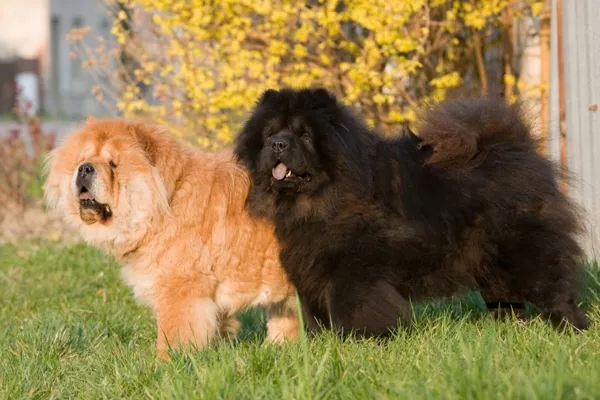 A fluffy Chow Chow, known for its protective instincts, standing calmly outdoors. This breed can be a medium to large size family protection dog.
A fluffy Chow Chow, known for its protective instincts, standing calmly outdoors. This breed can be a medium to large size family protection dog.
The Chow Chow is a distinctive medium-sized dog known for its lion-like mane, sturdy build, and unique blue-black tongue. Believed to originate from ancient Mongolia or Siberia, this breed holds one of the closest genetic links to wolves among domesticated dogs. While originally bred for various working roles, Chow Chows are not inherently aggressive or overly energetic. They adapt well to smaller living spaces like apartments, provided they receive daily walks.
Chow Chows are fiercely loyal to their families and generally good with children, though their independent and sometimes aloof nature means they thrive with consistent, gentle handling. They have a strong reputation for being highly protective of their territory, possessions, and specific family members, often displaying suspicion or even aggression towards strangers if not properly socialized from a young age. Their calm demeanor combined with their strong guarding instincts makes them a unique choice for a medium to large size family protection dog.
Adult Chow Chows typically stand between 43 to 50 cm tall and weigh 18 to 31 kgs, with a healthy lifespan of 12 to 15 years. Common health issues include ear infections, skin allergies, lameness, entropion, and cruciate disease.
9. Shar Pei
 A distinctive Shar Pei dog with wrinkled skin, known for its historical role as a guard dog, standing alertly.
A distinctive Shar Pei dog with wrinkled skin, known for its historical role as a guard dog, standing alertly.
The Shar Pei, also known as the Chinese Shar Pei, is a medium-sized dog instantly recognizable by its distinctive wrinkled skin, broad flat head, and a solid build. Like the Chow Chow, they possess a unique blue-black tongue. The name “Shar Pei” translates to “sandy coat” in Chinese, referring to their rough, bristly fur.
With a history tracing back to the Han Dynasty around 200 B.C. in China, Shar Peis were versatile working dogs. Their roles included guarding livestock and homes, hunting wild boar, and even dog fighting. This rich history underscores their protective nature and strong will. As a family protection dog, the Shar Pei is intensely loyal and devoted to its owners, often forming a strong bond. However, their independent and sometimes stubborn temperament requires an experienced owner committed to early socialization and consistent training. They can be wary of strangers and may react if they perceive a threat to their family or territory.
Male Shar Peis generally weigh between 25 to 29 kgs, while females range from 18 to 25 kgs. They stand approximately 45 to 51 cm tall. The average lifespan for a Shar Pei is around 10 years.
8. Akita Inu
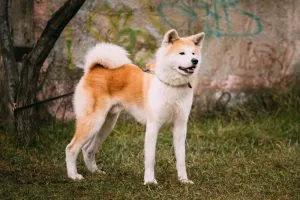 A majestic Akita Inu, a large and powerful protective dog breed, posing outdoors with an alert expression.
A majestic Akita Inu, a large and powerful protective dog breed, posing outdoors with an alert expression.
The Akita, a large and powerful breed, possesses a distinctive aloof attitude and a commanding presence. Its lineage is ancient, with ancestors believed to have existed between 8,000 BC and 200 BC in Japan. During the 19th century, as urban dwellers moved to rural areas, there was a demand for a large, powerful guardian, leading to the development of the Akita by crossing the Matagi-Inu with breeds like Mastiffs and Bulldogs. There are two main strains: the Japanese Akita (Akita Inu) and the American Akita.
Akitas are naturally territorial and typically reserved around strangers, making them excellent natural guardians. They are known for their profound loyalty to their families, often forming deep bonds. However, their strong-willed nature and potential for aggression towards other dogs, especially those of the same sex, necessitate early and thorough socialization and firm, consistent training. An experienced owner is crucial for managing this powerful breed effectively, ensuring they develop into well-mannered and reliable family protection dogs.
Male Akitas weigh 34 to 54 kgs and stand 61 to 71 cm tall, while females weigh 34 to 50 kgs and stand 61 to 66 cm tall. Their average lifespan is 10 to 12 years.
7. Staffordshire Bull Terrier
 A muscular Staffordshire Bull Terrier, a medium-sized dog known for loyalty and protective nature towards family, sitting outdoors.
A muscular Staffordshire Bull Terrier, a medium-sized dog known for loyalty and protective nature towards family, sitting outdoors.
The Staffordshire Bull Terrier, an English terrier, is a testament to muscularity, tenacity, and unwavering loyalty. Bred in the 17th and 18th centuries from English Bulldogs and Old English Terrier breeds for bull and bear baiting, their original purpose highlights their inherent bravery and strength. Despite their historical background, which was outlawed in the UK in the 1830s, modern Staffies are cherished for their affectionate nature, especially with children.
This breed has a notable fondness for its family and is intensely protective of them. While enthusiastic and playful, their energy can be overwhelming for very young children, so supervision is always recommended for kids under eight. A well-socialized and trained Staffie is an intelligent and devoted companion, making it a surprisingly effective medium-sized family protection dog that excels at alerting its family to potential threats and standing its ground when necessary.
The average Staffordshire Bull Terrier measures between 35 to 40 cm tall and weighs 13 to 17 kgs, with a healthy lifespan of 10 to 15 years. Staffies are prone to certain health conditions, with a higher risk of skin conditions, lameness, arthritis, and cruciate ligament issues.
6. Rottweiler
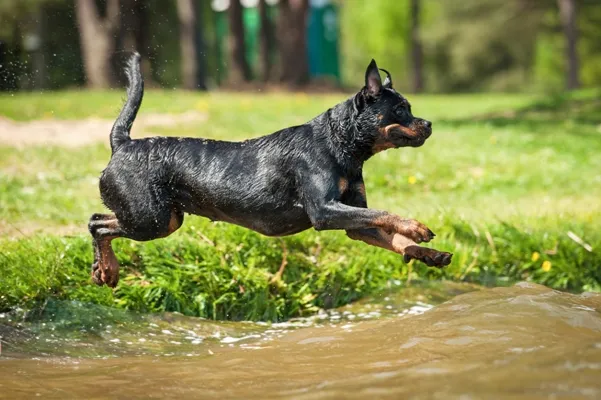 A powerful Rottweiler, an excellent medium to large size family protection dog, mid-jump during play, demonstrating its agility and strength.
A powerful Rottweiler, an excellent medium to large size family protection dog, mid-jump during play, demonstrating its agility and strength.
Rottweilers are famous for their large, muscular build and distinctive black and tan coats. Originally bred by the Romans as herding dogs, today’s Rottweiler excels in various roles, including guide dog, police dog, search and rescue dog, and of course, exceptional guard dog. Beyond their working capabilities, Rottweilers are fiercely loyal and devoted companions.
Despite some unfair media portrayals, Rottweilers are generally not dangerous dogs when properly trained and socialized from a young age. They possess a natural protective instinct that needs to be channeled through firm, consistent leadership. A well-adjusted Rottweiler is a docile and laid-back breed, making a great playmate for other pets and children within its family. Their intelligence and eagerness to please make them highly trainable, solidifying their reputation as one of the best large size family protection dogs. Early and continuous socialization is key to ensuring their inherent protective nature is managed responsibly.
Healthy male Rottweilers typically weigh between 50 and 60 kg and stand 61 to 69 cm tall. Females weigh 35 to 48 kg and stand 56 to 63 cm tall. The average lifespan for a Rottweiler is 8-10 years, though some can live up to 16 years.
5. Cane Corso
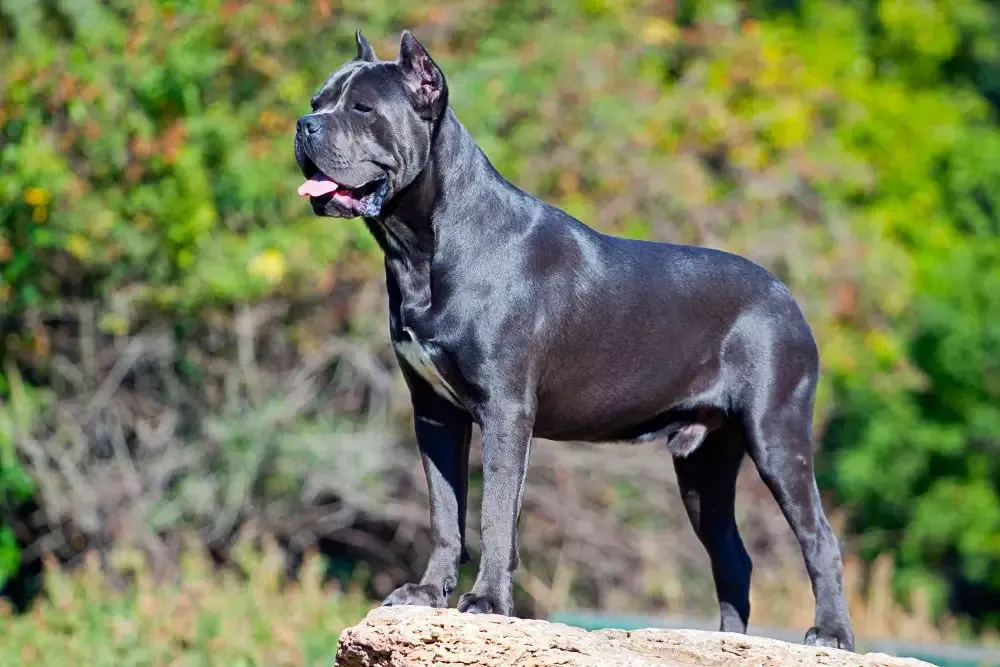 A vigilant Italian Cane Corso, a muscular and strong large protective dog breed, standing watch outdoors.
A vigilant Italian Cane Corso, a muscular and strong large protective dog breed, standing watch outdoors.
The Cane Corso, an ancient breed of Roman descent, hails from Italy and is characterized by its muscular, strong, and athletic appearance. Historically, these dogs were multi-purpose workers, employed for guarding the house, hunting big game, and even as war dogs by the Romans in both campaigns and arena sports. This formidable background speaks to their inherent protective qualities.
As a large size family protection dog, the Cane Corso is intensely loyal and eager to please its owner, but its energetic, strong, and heavy-set nature makes it challenging for inexperienced owners. Early and consistent training is essential to manage this stubborn breed, and comprehensive socialization as a puppy is an absolute must to curb any potential aggression and ensure they become well-adjusted family members. They require a firm, confident leader and thrive on having a job to do, whether it’s guarding the home or participating in dog sports.
The average Cane Corso stands between 64 and 68 cm tall and weighs between 45 to 50 kgs. A healthy Cane Corso typically lives for 10 to 11 years.
4. Boerboel
 A massive Boerboel, known for its fearless protective instincts and loyalty as a family guard dog, standing confidently outdoors.
A massive Boerboel, known for its fearless protective instincts and loyalty as a family guard dog, standing confidently outdoors.
The Boerboel, a very large domesticated working dog from South Africa, is muscular, exceedingly strong, and loyal to a fault. Bred specifically for guarding homesteads in harsh African conditions, this tough breed embodies resilience and fierce protectiveness. Boerboels are highly independent but thrive on attention from their owners. They are affectionate with children within their family and intensely loyal, but can sometimes exhibit a stubborn streak.
Early and consistent training is paramount for this breed, as their immense size and strong will can be challenging for first-time owners. The Boerboel is a ferocious guard dog that will bravely defend its family, even to the death, if they perceive a threat. For this reason, strong discipline, early socialization, and a confident, experienced owner are critical to channeling their protective instincts appropriately. When well-trained, they are an unparalleled large size family protection dog.
Boerboels are imposing dogs, measuring between 64 and 70 cm tall and weighing between 70 to 90 kgs. A healthy Boerboel will typically live for 9 to 13 years.
3. German Shepherd
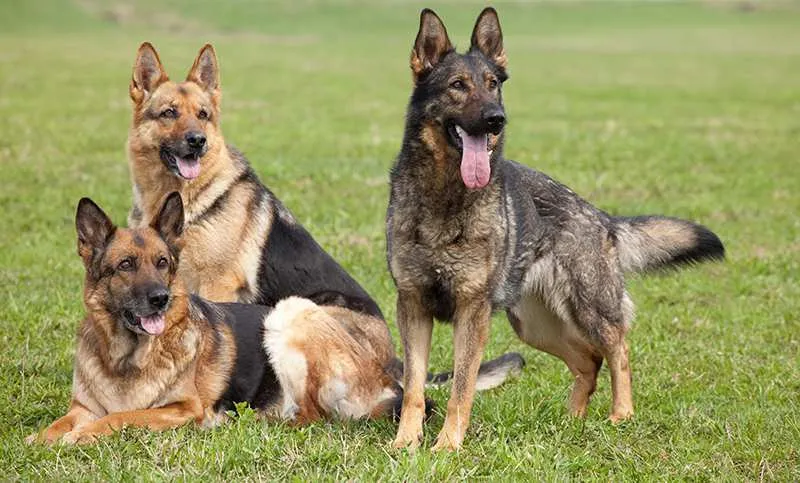 Three intelligent German Shepherds, highly effective family protection dogs, standing alertly in a grassy field.
Three intelligent German Shepherds, highly effective family protection dogs, standing alertly in a grassy field.
The German Shepherd is instantly recognizable by its wolf-like appearance, bushy tail, and pointy ears. While coat colors can vary, they often feature a striking mix of black and gold. This breed is celebrated globally for its exceptional intelligence, often topping lists of the smartest dog breeds. Their remarkable intelligence, obedience, and trainability make them one of the most adaptable and versatile dog breeds in the world, frequently employed in military, search and rescue, and police roles.
As a medium to large size family protection dog, German Shepherds are considered very safe when well-trained and extensively socialized from a young age. Their protective instincts are strong, but they are also known for their gentle nature with children and unwavering loyalty to their family. Early socialization to various people, places, and other animals is crucial to foster a balanced temperament and prevent over-protectiveness or fear-based aggression. They require mental stimulation and physical exercise to thrive.
Healthy male German Shepherds typically weigh 30 to 40 kg and stand 60 to 65 cm tall, while females are usually 22 to 32 kg and stand 55 to 60 cm tall. Their lifespan is generally 9-13 years, with some living up to 20. German Shepherds are more prone to certain health issues, including skin conditions, hip dysplasia, and arthritis. For those considering a German Shepherd, exploring all aspects, including specific characteristics of German Shepherd breeds that don’t shed if that’s a preference, can be helpful, though classic GSDs are known to shed.
2. Doberman Pinscher
 An alert Doberman Pinscher, a sleek and agile medium to large size family protection dog, standing with focused intensity.
An alert Doberman Pinscher, a sleek and agile medium to large size family protection dog, standing with focused intensity.
Doberman Pinschers typically have a sleek, compact, and square build, reflecting their athleticism, endurance, and agility. While historically portrayed as aggressive working dogs, modern Dobermans possess a much more even temperament. They are exceptionally smart, profoundly loyal, and highly trainable, making them excellent candidates for a medium to large size family protection dog. While they retain protective instincts, they are usually very sociable with humans and other dogs when properly socialized.
Dobermans are high-energy dogs that require daily long walks or jogs, where the human must always lead to reinforce their position as “pack leader.” Their intelligence means they excel in obedience and protection training, quickly grasping commands and performing tasks with precision. Consistent training, mental stimulation, and ample physical activity are vital to prevent boredom and destructive behaviors. They bond deeply with their families and are vigilant guardians, always alert to their surroundings.
Healthy male Dobermans usually weigh between 34 and 45 kg and stand approximately 68 cm tall. Females weigh between 27 and 41 kg and stand about 64 cm tall. The average lifespan of a Doberman is 10-11 years, with some living up to 13. Dobermans are one of the breeds most at risk of blood clotting disorders and certain traumatic injuries.
1. Bullmastiff
 A powerful Bullmastiff, an imposing and loyal large protective dog breed, standing majestically outdoors.
A powerful Bullmastiff, an imposing and loyal large protective dog breed, standing majestically outdoors.
The Bullmastiff is a large, strong breed that has been utilized as a guard dog for many years. This majestic dog features a short coat that lies flat on its muscular body, with colors including fawn, brindle, and often black markings on the head. Developed in the mid-19th century by English gamekeepers, they were bred as a quiet, powerful, and fearless breed to track down poachers. Their immense size allowed them to hold down intruders without inflicting severe bites, earning them the moniker “Gamekeeper’s Night-Dog.” They lived as integral members of the gamekeeper’s family, serving as both companion and guardian.
Despite their formidable size and strength, Bullmastiffs do not require an excessive amount of exercise. Regular walks are suggested for both physical activity and mental stimulation. While Bullmastiff puppies are often full of energy and excitement, adults tend to have a calm and settled nature. However, if provoked or if their family is threatened, they become fierce and unwavering protectors, hard to deter. This blend of calm demeanor and formidable protective instinct makes them an ideal choice for the best large size family protection dog, especially for those seeking a deterrent presence with a gentle family side.
Male Bullmastiffs stand between 63 to 69 cm tall and weigh a hefty 50 to 60 kgs, while females stand 61 to 66 cm and weigh 45 to 54 kgs. The average lifespan of the Bullmastiff is 10 years. This breed is one of those most at risk for Lymphoma (cancer). Owners might consider exploring options for dog breeds that don’t shed as much if hair is a concern, though Bullmastiffs, with their short coats, are relatively easy to groom.
Beyond the List: Choosing the Right Protection Dog for Your Family
Selecting the best medium to large size family protection dog is a significant decision that extends beyond just breed popularity. It involves a deep understanding of your family’s lifestyle, living environment, and commitment to responsible pet ownership. While the breeds listed above are renowned for their protective capabilities, their suitability for your family depends on several critical factors:
- Training and Socialization: Every protection dog, regardless of breed, requires extensive and consistent training and socialization from puppyhood. This includes obedience, boundary training, and exposure to various people, places, and other animals. Without it, protective instincts can become misdirected or lead to behavioral issues.
- Time Commitment: These intelligent and powerful dogs demand a significant time investment for exercise, mental stimulation, and training. They thrive on having a purpose and being integrated into family activities.
- Living Environment: While some larger breeds can adapt to smaller homes with sufficient exercise, many require ample space. Consider your yard size, local dog parks, and access to training facilities.
- Family Dynamics: Evaluate your family’s experience with dogs, especially large or protective breeds. The presence of young children or other pets will influence the ideal breed choice and the level of supervision and training required. Some breeds that are protective might also be considered dog breeds that don’t shed much, combining two desired traits.
- Health and Lifespan: Be aware of common health issues associated with specific breeds and factor in the potential veterinary costs and care required throughout their lives.
Conclusion: A Loyal Guardian and Cherished Companion
Choosing the best medium to large size family protection dog is about finding a loyal guardian that also seamlessly integrates into your home as a beloved family member. The breeds discussed—from the stoic Chow Chow to the formidable Bullmastiff—offer a remarkable blend of protective instincts, intelligence, and unwavering devotion. Each brings its unique history, temperament, and needs to the table, requiring a committed owner prepared to invest in their training, socialization, and overall well-being.
Ultimately, a truly effective family protection dog is a reflection of its upbringing. With consistent positive reinforcement, early and broad socialization, and a deep understanding of their breed-specific traits, these magnificent animals can provide unparalleled security and companionship. For peace of mind and the well-being of your canine protector, always consider comprehensive pet care, including regular veterinary check-ups and potentially pet insurance options to cover unexpected health concerns. A well-cared-for and well-trained protection dog is not just a deterrent; it’s a confident, balanced, and cherished member of your family, ready to defend those it loves most.
